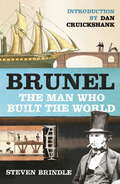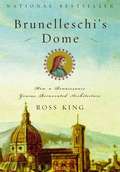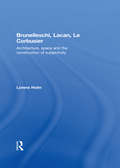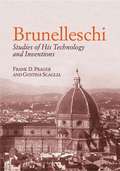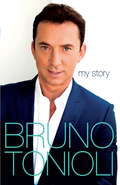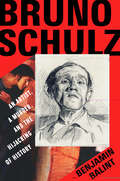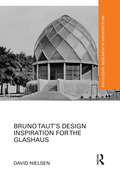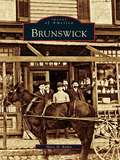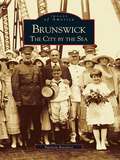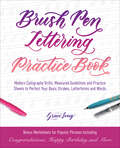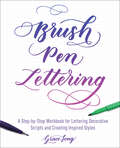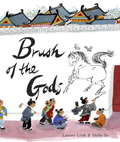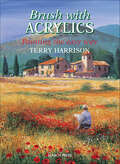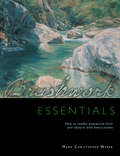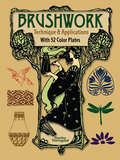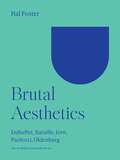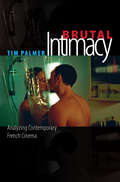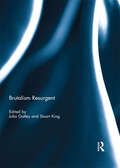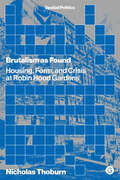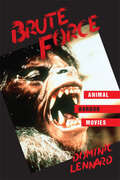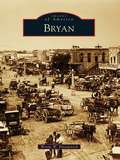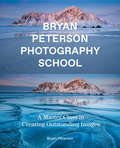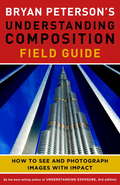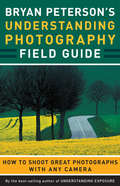- Table View
- List View
Brunel: The Man Who Built the World
by Steven BrindleA celebration of the life and engineering achievements of Isambard Kingdom Brunel by two of the world's foremost authorities.In his lifetime, Isambard Kingdom Brunel towered over his profession. Today, he remains the most famous engineer in history, the epitome of the volcanic creative forces which brought about the Industrial Revolution - and brought modern society into being.Brunel's extraordinary talents were drawn out by some remarkable opportunities - above all his appointment as engineer to the new Great Western Railway at the age of 26 - but it was his nature to take nothing for granted, and to look at every project, whether it was the longest railway yet planned, or the largest ship ever imagined, from first principles. A hard taskmaster to those who served him, he ultimately sacrificed his own life to his work in his tragically early death at the age of 53. His legacy, though, is all around us, in the railways and bridges that he personally designed, and in his wider influence.This fascinating new book draws on Brunel's own diaries, letters and sketchbooks to understand his life, times, and work.
Brunelleschi's Dome: How a Renaissance Genius Reinvented Architecture
by Ross KingBrunelleschi's Dome is the story of how a Renaissance genius bent men, materials, and the very forces of nature to build an architectural wonder we continue to marvel at today. Denounced at first as a madman, Brunelleschi was celebrated at the end as a genius. He engineered the perfect placement of brick and stone, built ingenious hoists and cranes (among some of the most renowned machines of the Renaissance) to carry an estimated 70 million pounds hundreds of feet into the air, and designed the workers' platforms and routines so carefully that only one man died during the decades of construction--all the while defying those who said the dome would surely collapse and his own personal obstacles that at times threatened to overwhelm him. <p><p> This drama was played out amid plagues, wars, political feuds, and the intellectual ferments of Renaissance Florence-- events Ross King weaves into the story to great effect, from Brunelleschi's bitter, ongoing rivalry with the sculptor Lorenzo Ghiberti to the near catpure of Florence by the Duke of Milan. King also offers a wealth of fascinating detail that opens windows onto fifteenth-century life: the celebrated traditions of the brickmaker's art, the daily routine of the artisans laboring hundreds of feet above the ground as the dome grew ever higher, the problems of transportation, the power of the guilds. <p> Even today, in an age of soaring skyscrapers, the cathedral dome of Santa Maria del Fiore retains a rare power to astonish. Ross King brings its creation to life in a fifteenth-century chronicle with twenty-first-century resonance.
Brunelleschi, Lacan, Le Corbusier: Architecture, Space and the Construction of Subjectivity
by Lorens HolmThis well-argued, analytic text provides a greater understanding of spatial issues in the field of architecture. Re-interpreting the fifteenth century demonstration of perspective, Lorens Holm puts it in relation to today’s theories of subjectivity and elaborates for the first time the theoretical link between architecture and psychoanalysis.Divided into three sections, Brunelleschi, Lacan, Le Corbusier argues that perspective remains the primary and most satisfying way of representing form, because it is the paradigmatic form of spatial consciousness. Well-illustrated with over 100 images, this compelling book is a valuable study of this key aspect of architectural study and practice, making it an essential read for architects in their first year or their fiftieth.
Brunelleschi: Studies of His Technology and Inventions
by Gustina Scaglia Frank D. PragerA pioneer of Italian Renaissance architecture, Filippo Brunelleschi is most famous for his daring and original ideas, among them the magnificent dome of Florence's famed Santa Maria del Fiore cathedral. This comprehensive book describes how he created the structure, construction concepts, and other inventions. 28 halftones, 18 line illustrations.
Bruno My Story
by Bruno TonioliMeet Bruno Tonioli - Strictly Come Dancing judge, wildcat choreographer and stardust magnet. With his irrepressible personality and Italian exuberance, Bruno has become a TV sensation, settling the fate of Britain's ballroom hopefuls during the nation's favourite Saturday night show. Bruno's journey is mind-blowing. He fled from home at eighteen to join the dance company La Grande Eugene and travelled around Europe; he later coached the actress Goldie Hawn as a dance instructor, and orchestrated lavish productions for TV, film and pop videos, where he worked alongside The Rolling Stones, Freddie Mercury, Duran Duran and Tina Turner. Along the way Bruno has Tangoed with high fashion, performed the Cha Cha Cha with untameable pop vixens Bananarama and danced an emotional Waltz with bereavement and breakdown before settling in the perfect location - a seat on the judging panel of Strictly Come Dancing, where he wowed the nation at home and in Hollywood with his passion for dance and an excitable turn of phrase. My Story tears away the glittery wrapping of this most exuberant and loveable of TV stars. Strap yourselves in for a wild and sexy ride with more frills than Versailles.
Bruno Schulz: An Artist, a Murder, and the Hijacking of History
by Benjamin BalintA fresh portrait of the Polish-Jewish writer and artist, and a gripping account of the secret operation to rescue his last artworks. The twentieth-century artist Bruno Schulz was born an Austrian, lived as a Pole, and died a Jew. First a citizen of the Habsburg monarchy, he would, without moving, become the subject of the West Ukrainian People’s Republic, the Second Polish Republic, the USSR, and, finally, the Third Reich. Yet to use his own metaphor, Schulz remained throughout a citizen of the Republic of Dreams. He was a master of twentieth-century imaginative fiction who mapped the anxious perplexities of his time; Isaac Bashevis Singer called him “one of the most remarkable writers who ever lived.” Schulz was also a talented illustrator and graphic artist whose masochistic drawings would catch the eye of a sadistic Nazi officer. Schulz’s art became the currency in which he bought life. Drawing on extensive new reporting and archival research, Benjamin Balint chases the inventive murals Schulz painted on the walls of an SS villa—the last traces of his vanished world—into multiple dimensions of the artist’s life and afterlife. Sixty years after Schulz was murdered, those murals were miraculously rediscovered, only to be secretly smuggled by Israeli agents to Jerusalem. The ensuing international furor summoned broader perplexities, not just about who has the right to curate orphaned artworks and to construe their meanings, but about who can claim to stand guard over the legacy of Jews killed in the Nazi slaughter. By re-creating the artist’s milieu at a crossroads not just of Jewish and Polish culture but of art, sex, and violence, Bruno Schulz itself stands as an act of belated restitution, offering a kaleidoscopic portrait of a life with all its paradoxes and curtailed possibilities.
Bruno Taut's Design Inspiration for the Glashaus (Routledge Research in Architecture)
by David NielsenAs a formative exemplar of early architectural modernism, Bruno Taut’s seminal exhibition pavilion the Glashaus (literally translated Glasshouse) is logically part of the important debate of rethinking the origins of modernism. However, the historical record of Bruno Taut’s Glashaus has been primarily established by one art historian and critic. As a result the historical record of the Glashaus is significantly skewed toward a singlular notion of Expressionism and surprisingly excludes Taut’s diverse motives for the design of the building. In an effort to clarify the problematic historical record of the Glashaus, this book exposes Bruno Taut’s motives and inspirations for its design. The result is that Taut’s motives can be found in yet unacknowledged precedents like the botanical inspiration of the Victoria regia lily; the commercial interests of Frederick Keppler as the Director of the Deutche Luxfer Prismen Syndikat; and imitation that derived openly from the Gothic. The outcome is a substantial contribution to the re-evaluation of the generally accepted histories of the modern movement in architecture.
Brunswick
by Mary H. RubinEel Pot, Buffalo Wallows, Coxson Rest, Tankerville, Hawkins' Merry-Peep-O-Day, Berlin--readers might not recognize a few of the names the area now known as Brunswick went by in years past. Brunswick, Maryland, just six miles by towpath from historic Harpers Ferry, West Virginia, is rich in history. The area holds Civil War importance and served as a supply depot for the Union army after the Battle of Antietam. Primarily known as a canal town until the late 1800s, the town became an important rail center when the Baltimore and Ohio (B&O) Railroad came totown and set up huge rail operations. Today the town sits on the now-quiet banks of the Chesapeake and Ohio (C&O) Canal, and the train whistles don't sound quite so often, but this community continues to draw visitors seeking history, outdoor recreation, andsmall-town charm.
Brunswick: The City by the Sea (Images of America)
by Patricia BarefootLocated on the coast of southeast Georgia and the sinuous sweep of poet Sidney Lanier's famed "Marshes of Glynn," Brunswick, Georgia boasts a history rich beyond measure. Dating from its layout in 1771 on the "Oglethorpe Plan" by surveyor George McIntosh, the new town emphasized an Anglo-Germanic heritage, and featured a grid repeat pattern of regularly spaced squares and town lots. In the 1830s, a flurry of entrepreneurial activity included the plan of "New Town," which extended from the boundaries of Old Town. A few of Brunswick's most spectacular architectural treasures stand today within the boundaries of New Town near the Courthouse Mall. Built upon a peninsula, the seaside setting and Georgia's abundant natural resources have proven inspiring and lucrative assets for the port city and its people. Although buffeted by wars and epidemics, panics and depressions, a diverse population has endured and demonstrated extraordinary resilience. While in 1902 Brunswick stood first in lumber and second in naval stores production compared with other south Atlantic ports, today auto import and export, agri-commodities, and forest products provide focus for port activity. Soon the citizens of Brunswick-Glynn County will welcome a 185-foot vertical clearance, cable-stayed golden "bridge to the future." At the millennium's dawn, a renewed emphasis on restoring old buildings and homes, economic vitality, an award-winning Main Street program, and revitalization downtown promise a bright future.<
Brush Pen Lettering Practice Book: Modern Calligraphy Drills, Measured Guidelines and Practice Sheets to Perfect Your Basic Strokes, Letterforms and Words
by Grace SongPractice your brush pen lettering til you’re perfect with expert drills, tips, and exercises.If you want to take your hand lettering to the next level, you need to practice, practice, practice. But merely writing the same letter over and over often leads to repeating the same mistake instead of improving your skill.Packed with expert drills, tips and exercises, Brush Pen Lettering Practice Book provides the smart coaching and blank workspace to make your daily practice easier, more efficient and more fun. It’s the ideal way to speed you on your way to creating gorgeous lettering styles.The perfect companion to author Grace Song’s Brush Pen Lettering, this handy workbook features helpful practice pages with guided lines, hints and even specific letter form combinations for many popular words, including:• Congratulations• Greetings• Wedding• Happy Birthday
Brush Pen Lettering: A Step-by-Step Workbook for Learning Decorative Scripts and Creating Inspired Styles (Hand-lettering And Calligraphy Practice Ser.)
by Grace SongTHE FIRST BOOK DEDICATED ENTIRELY TO THE USE AND MASTERY OF MODERN BRUSH PENSDrawing gorgeous letters, words and phrases with a brush pen doesn&’t have to be difficult! Brush Pen Lettering will show you how to create your own unique style. To help you on your lettering journey, this comprehensive how-to guide includes:• DIY projects• Tips and Tricks• Color Photographs• Inspiring Ideas• Step-by-step instructions• Practice sheets
Brush of the Gods
by Lenore Look Meilo SoWho wants to learn calligraphy when your brush is meant for so much more? Wu Daozi (689-758), known as China's greatest painter and alive during the T'ang Dynasty, is the subject of this stunning picture book. When an old monk attempts to teach young Daozi about the ancient art of calligraphy, his brush doesn't want to cooperate. Instead of characters, Daozi's brush drips dancing peonies and flying Buddhas! Soon others are admiring his unbelievable creations on walls around the city, and one day his art comes to life! Little has been written about Daozi, but Look and So masterfully introduce the artist to children.
Brush with Acrylics: Painting the Easy Way
by Terry HarrisonAcrylics are easy to master and extremely versatile. Paint can be applied thick like oils, or in washes like watercolour. Also, techniques can be mixed to create unusual and different effects. Using a range of brushes, Terry explores all these different techniques showing how to capture atmosphere, texture and detail. He paints a selection of beautiful landscapes, seascapes and buildings with ease, showing how to apply colour to produce stunning pictures of atmospheric skies, mist covered rivers, vibrant fields of flowers, rustic buildings, calm estuaries and more.With many hot tips and a wealth of practical advice, Terry presents an inspiring sequence of step-by-step demonstrations which aim to build up skills and encourage the artist to create their own original paintings.
Brushstroke and Emergence: Courbet, Impressionism, Picasso
by James D. HerbertNo pictorial device in nineteenth-century French painting more clearly represented the free-ranging self than the loose brushstroke. From the romantics through the impressionists and post-impressionists, the brushstroke bespoke autonomous artistic individuality and freedom from convention. Yet the question of how much we can credit to the individual brushstroke is complicated--and in Brushstroke and Emergence, James D. Herbert uses that question as a starting point for an extended essay that draws on philosophy of mind, the science of emergence, and art history. Brushstrokes, he reminds us, are as much creatures of habit and embodied experience as they are of intent. When they gather in great numbers they take on a life of their own, out of which emerge complexity and meaning. Analyzing ten paintings by Courbet, Manet, Cézanne, Monet, Seurat, and Picasso, Herbert exposes vital relationships between intention and habit, the singular and the complex. In doing so, he uncovers a space worthy of historical and aesthetic analysis between the brushstroke and the self.
Brushwork Essentials: How To Render Expressive Form And Texture With Every Stroke
by Mark Christopher WeberThe Keys To Superior Painting Can Be Yours!These are the brushstrokes with which great oil paintings are created. They give you the power to convey everything from realistic light and shadow to dynamic mood and tension.Mark Christopher Weber shows you how to mix and load paint, shape your brush and apply a variety of intriguing strokes in nine easy-to-follow demonstrations. Special icons appear throughout the book to indicate which brush to use for each technique and when. It couldn't be any easier.
Brushwork Technique and Applications: With 52 Color Plates (Dover Art Instruction Ser.)
by Stanley ThorogoodThis handbook and teacher's guide by a noted instructor presents a wealth of annotated illustrations that introduce practice brushstrokes and designs. In addition to instructions on color mixing, paper selection, and proper brush handling, the book features 52 full-color plates. The vibrant illustrations, which also serve as repetition exercises for aspiring pottery artists, incorporate elements of Art Nouveau decor as well as Etruscan and Hispano-Moresque ornaments.Stanley Thorogood discusses and depicts various brush strokes, including blob work applied to pattern-making, the formation of patterns from simple strokes, the principle of radiation, and natural and conventional forms drawn with the brush. He further explores the use of the brush in suggesting ideas, the decoration of vase forms, direct freehand drawing and application, and direct designing on given lines. Additional topics include sketching directly from plant life and historic brushwork.
Brutal Aesthetics: Dubuffet, Bataille, Jorn, Paolozzi, Oldenburg (The A. W. Mellon Lectures in the Fine Arts #67)
by Hal FosterHow artists created an aesthetic of “positive barbarism” in a world devastated by World War II, the Holocaust, and the atomic bombIn Brutal Aesthetics, leading art historian Hal Foster explores how postwar artists and writers searched for a new foundation of culture after the massive devastation of World War II, the Holocaust, and the atomic bomb. Inspired by the notion that modernist art can teach us how to survive a civilization become barbaric, Foster examines the various ways that key figures from the early 1940s to the early 1960s sought to develop a “brutal aesthetics” adequate to the destruction around them.With a focus on the philosopher Georges Bataille, the painters Jean Dubuffet and Asger Jorn, and the sculptors Eduardo Paolozzi and Claes Oldenburg, Foster investigates a manifold move to strip art down, or to reveal it as already bare, in order to begin again. What does Bataille seek in the prehistoric cave paintings of Lascaux? How does Dubuffet imagine an art brut, an art unscathed by culture? Why does Jorn populate his paintings with “human animals”? What does Paolozzi see in his monstrous figures assembled from industrial debris? And why does Oldenburg remake everyday products from urban scrap?A study of artistic practices made desperate by a world in crisis, Brutal Aesthetics is an intriguing account of a difficult era in twentieth-century culture, one that has important implications for our own.Published in association with the Center for Advanced Study in the Visual Arts, National Gallery of Art, Washington, DCPlease note: All images in this ebook are presented in black and white and have been reduced in size.
Brutal Intimacy: Analyzing Contemporary French Cinema (Wesleyan Film)
by Tim PalmerBrutal Intimacy is the first book to explore the fascinating films of contemporary France, ranging from mainstream genre spectaculars to arthouse experiments, and from wildly popular hits to films that deliberately alienate the viewer. Twenty-first-century France is a major source of international cinema--diverse and dynamic, embattled yet prosperous--a national cinema offering something for everyone. Tim Palmer investigates France's growing population of women filmmakers, its buoyant vanguard of first-time filmmakers, the rise of the controversial cinema du corps, and France's cinema icons: auteurs like Olivier Assayas, Claire Denis, Bruno Dumont, Gaspar Noe, and stars such as Vincent Cassel and Jean Dujardin. Analyzing dozens of breakthrough films, Brutal Intimacy situates infamous titles alongside many yet to be studied in the English language. Drawing on interviews and the testimony of leading film artists, Brutal Intimacy promises to be an influential treatment of French cinema today, its evolving rivalry with Hollywood, and its ambitious pursuits of audiences in Europe, North America, and around the world.
Brutalism Resurgent
by Julia Gatley and Stuart KingBrutalism had its origins in béton brut – concrete in the raw – and thus in the post-war work of Le Corbusier. The British architects Alison and Peter Smithson used the term "New Brutalism" from 1953, claiming that if their house in Soho had been built, "it would have been the first exponent of the ‘New Brutalism’ in England". Reyner Banham famously gave the movement a series of characteristics, including the clear expression of a building’s structure and services, and the honest use of materials in their "as-found" condition. The Smithsons and Banham promoted the New Brutalism as ethic rather than aesthetic, privileging truth to structure, materials and services and the gritty reality of the working classes over the concerns of the bourgeoisie. But Brutalist architecture changed as it was taken up by others, giving rise to more sculptural buildings flaunting their raw materials, including off-form concrete, often in conjunction with bold structural members. While Brutalism fell out of vogue in the 1980s, recent years have seen renewed admiration for it. This volume is consistent with this broader resurgence, presenting new scholarship on Brutalist architects and projects from Skopje to Sydney, and from Harvard to Haringey. It will appeal to readers interested in twentieth-century architecture, and modern and post-war heritage. This book was originally published as a special issue of Fabrications: the Journal of the Society of Architectural Historians, Australia and New Zealand.
Brutalism as Found: Housing, Form, and Crisis at Robin Hood Gardens (Spatial Politics)
by Nicholas ThoburnA critical appropriation of Brutalism in the crisis conditions of today.The Robin Hood Gardens public-housing estate in East London, completed in 1972, was designed by Alison and Peter Smithson as an ethical and aesthetic encounter with the flux and crises of the social world. Now demolished by the forces of speculative development, this Brutalist estate has been the subject of much dispute. But the clichéd terms of debate—a &“concrete monstrosity&” or a &“modernist masterpiece&”—have marginalized the estate&’s residents and obscured its architectural originality. Recovering the social in the architectural, this book centers the estate&’s lived experience of a multiracial working class, not to displace the architecture&’s sensory qualities of matter and form, but to radicalize them for our present.Immersed in the materials, atmospheres, social forms and afterlives of this experimental estate, Robin Hood Gardens is reconstructed here as a socio-architectural expression of our times out of joint.
Brute Force: Animal Horror Movies (SUNY series, Horizons of Cinema)
by Dominic LennardIt's always been a wild world, with humans telling stories of killer animals as soon as they could tell stories at all. Movies are an especially popular vehicle for our fascination with fierce creatures. In Brute Force, Dominic Lennard takes a close look at a range of cinematic animal attackers, including killer gorillas, sharks, snakes, bears, wolves, spiders, and even a few dinosaurs. Lennard argues that animal horror is not so much a focused genre as it is an impulse, tapping into age-old fears of becoming prey. At the same time, these films expose conflicts and uncertainties in our current relationship with animals. Movies considered include King Kong, Jaws, The Grey, Them!, Arachnophobia, Jurassic Park, Snakes on a Plane, An American Werewolf in London, and many more. Drawing on insights from film studies, art history, cognitive science, and evolutionary psychology, Brute Force is an engaging critical exploration—and appreciation—of cinema's many bad beasts.
Bryan
by Wendy W. PatzewitschCotton was king during Bryan's early history. Many prominent planters and farmers lived on the high ground between the Brazos and Navasota Rivers in the market town of Bryan, and the cotton crop thrived in the fertile Brazos River Bottom. The railroad's arrival after the Civil War provided a link to textile mills in other parts of the world via the nearby ports of Houston and Galveston. Land availability and economic opportunity attracted settlers not only from the southeastern United States, but also from Italy and Eastern Europe. When cotton's economic dominance began to wane, other agricultural crops, livestock, a strong commitment to education, and oil and gas production diversified the local economy. As the seat of county government, and with its close proximity to Texas A&M University, Bryan today is a vibrant community strategically located in the heart of the Texas Urban Triangle.
Bryan Peterson Photography School: A Master Class in Creating Outstanding Images
by Bryan PetersonA master class from the acclaimed photographer, bestselling author, and popular teacher, featuring lessons and workshops previously available only through the Bryan Peterson School of PhotographyHave you ever dreamed of attending a photography class led by one of the most respected professional photographers in the world? Step right up! Bryan Peterson invites readers to participate in his famous workshops, sharing all his best tips and tricks for capturing subjects and landscapes in a magical moment. Using before-and-after examples from real-life students, Bryan reveals the keys to improving your craft with the right angle, aperture, lens, and filters. Including lessons in shutter speed, white balance, light meter, lens choice and point of view, Photoshop, and so much more, Bryan Peterson Photography School is a unique opportunity to hone your skills and learn how to produce impeccable photographs.
Bryan Peterson's Understanding Composition Field Guide: How to See and Photograph Images with Impact
by Bryan F. PetersonLearn to "see" more compelling images with this on-the-go field guide from Bryan Peterson! What makes an image amazing? Believe it or not, it is not about the content. What makes a photo compelling is the arrangement of that content--in other words, its composition. The right composition gives your images impact and emotion; the wrong one leaves them flat. In this handy, take-anywhere guide, renowned photographer, instructor, and bestselling author Bryan Peterson frees amateur photographers from the prejudices of what is "beautiful" or "ugly" so that they can instead focus on color, line, light, and pattern. Get the tools you need to show your distinct voice and point of view in every image you shoot. With this guide in your camera bag, you'll be equipped not only to "see" beautiful images but to successfully shoot them each and every time. Also available as an ebook
Bryan Peterson's Understanding Photography Field Guide: How To Shoot Great Photographs With Any Camera
by Bryan PetersonDistilled from Peterson's popular previous titles, this single volume covers it all: exposure, shutter speed, composition and color, portraiture, the digital darkroom, printing, and aperture--all to help readers achieve the "wow" shots that are their ultimate goal.
